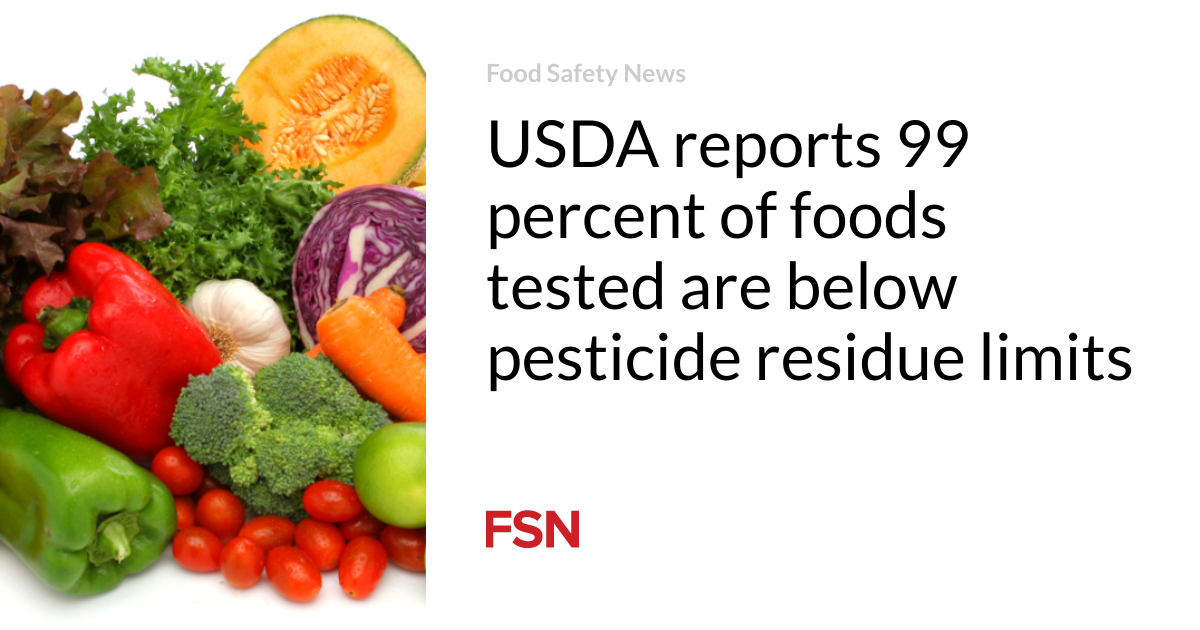
For its 31st annual report on pesticide residues in food, the Agricultural Marketing Service of the USDA has good news.
“In 2021, over 99 percent of the samples tested had residues below the tolerances established by the EPA with 24.0 percent having no detectable residue,” according to the report released on Dec. 26.
Referred to as the Pesticide Data Program (PDP), the testing program checked 10,127 samples in 2021. Of those samples, 94 percent were fresh and processed fruit and vegetables. Fresh and processed fruit and vegetables tested during 2021 were: blueberries (fresh and frozen), broccoli, cantaloupe, carrots, cauliflower, celery, eggplant, grape juice, green beans, peaches (fresh and frozen), pears, plums, summer squash, sweet bell peppers, tangerines, watermelon, and winter squash.
Corn grain and butter were also tested during 2021, accounting for 4.1 and 1.7 percent of the samples collected in 2021, respectively.
Domestic samples accounted for 67.8 percent of the samples, while 30.8 percent were imported, 0.9 percent were of mixed national origin, and 0.5 percent were of unknown origin.
Residues exceeding the tolerance were detected in less than 1 percent (0.53) percent, or 54, samples of the 10,127 total samples tested. Of these 54 samples, 29 were domestic, 24 were imported, and 1 was of unknown origin. Residues with no established tolerance were found in 3.7 percent, or 374 samples, of the 10,127 samples tested. Of these 374 samples, 220 were domestic, 150 were imported, and 4 were of unknown origin.
“PDP is a voluntary program and is not designed to enforce tolerances. However, PDP informs the U.S. Food and Drug Administration and EPA of presumptive tolerance violations if detected residues exceed the EPA tolerance or if residues are detected that have no EPA tolerance established,” according to the report.
“Ultimately, if EPA determines a pesticide use is not safe for human consumption, EPA will mitigate exposure to the pesticide through actions such as amending the pesticide label instructions or changing or revoking a pesticide residue tolerance, or not registering a new use.”
Of foremost concern in selecting the foods to be tested is the likelihood that the foods will be consumed by infants and children who pesticide residues than most adults can have more effect.
“USDA uses the data to better understand the relationship of pesticide residues to agricultural practices and to implement USDA’s Integrated Pest Management objectives. USDA also works with U.S. growers to improve agricultural practices and to facilitate the adoption of integrated pest management techniques, including judicious use of pesticides, throughout the food supply chain,” according to the report.
“The PDP is not designed for the enforcement of EPA pesticide residue tolerances. Rather, the U.S. Food and Drug Administration (FDA) is responsible for enforcing EPA tolerances. The PDP provides FDA and EPA with monthly reports of pesticide residue testing and informs the FDA if residues detected to exceed the EPA tolerance or have no EPA tolerance established.”
The PDP methodology includes working with state agencies representing census regions of the country that include nearly half of the U.S. population. In 2021 the program tested samples from California, Colorado, Florida, Maryland, Michigan, New York, Ohio, Texas, and Washington.
The number of samples collected by each state is apportioned according to that State’s population.
Samples are randomly chosen close to the time and point of consumption at distribution centers rather than at the farm gate and reflect what is typically available to the consumer throughout the year. Samples are selected without regard to country of origin, variety, growing season, or organic labeling.
Because PDP data are used for risk assessments, PDP laboratory methods are geared to detect very low levels of pesticide residues, even when those levels are well below the tolerances established by EPA. Before testing, PDP analysts washed samples for 15 to 20 seconds with gently running cold water as a consumer may do; no chemicals, soaps, or special washes were used.
PDP data are provided to EPA for its consideration in setting and reviewing tolerances. FDA monitors food in interstate commerce to ensure that these limits are not exceeded.
The full results for more than 2.7 million analyses, representing each pesticide monitored on each commodity, are too numerous to be included in their entirety in the summary report, according to the PDP. However, the complete PDP database file for 2021 along with annual summaries and database files for previous years are available on the PDP website at http://www.ams.usda.gov/pdp or by contacting MPD at amsmpo.data@usda.gov.
PDP data are also available using the PDP database search tool that can be accessed at: https://apps.ams.usda.gov/ pdp.
For more information about PDP, please visit the program website. For additional information about pesticides and food, please visit EPA’s website.
(To sign up for a free subscription to Food Safety News, click here)
